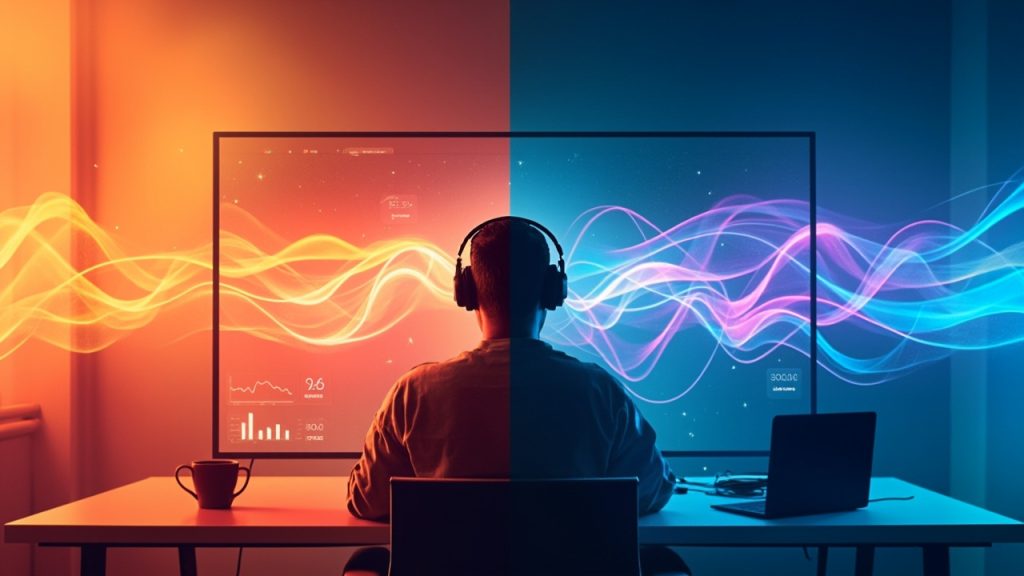Have you ever noticed how certain songs instantly energize you during a workout, while others help you focus during deep work sessions? The secret lies in something surprisingly specific: music tempo productivity connections that directly impact your brain’s performance. Research from neuroscience labs worldwide reveals that the beats per minute (BPM) of your background music can dramatically influence your cognitive abilities, emotional state, and overall work efficiency.
In our modern workplace, where distractions are constant and productivity demands are higher than ever, understanding how to harness the power of musical tempo has become a game-changing skill. Whether you’re tackling complex analytical tasks, brainstorming creative solutions, or powering through routine administrative work, the right tempo can be your secret weapon for enhanced performance. This comprehensive guide will explore the fascinating science behind how music tempo affects your brain and provide actionable strategies for optimizing your productivity through strategic sound selection.
What is Music Tempo and How Does It Impact Your Brain
Music tempo, measured in beats per minute (BPM), represents the speed at which a musical piece progresses. This seemingly simple metric triggers complex neurological responses that directly influence your cognitive performance, emotional regulation, and physiological arousal levels. When sound waves enter your auditory cortex, they activate neural networks that extend far beyond mere hearing, creating cascading effects throughout your entire nervous system.
The brain’s response to tempo involves multiple regions working in synchronized harmony. Your auditory cortex processes the rhythmic patterns, while the motor cortex begins anticipating and mirroring the beat through subtle muscle activations. Meanwhile, the limbic system evaluates the emotional content, and the prefrontal cortex adjusts attention and focus levels accordingly. This intricate dance of neural activity explains why a 120 BPM track can energize your morning routine, while a 60 BPM composition promotes deep concentration.
Recent neuroimaging studies have revealed that tempo directly influences brainwave patterns, with faster tempos promoting beta waves associated with alertness and active thinking, while slower tempos encourage alpha waves linked to relaxation and creative insight. Understanding these mechanisms allows you to strategically select musical tempos that align with your desired mental state and optimize your cognitive performance for specific tasks.
The Science Behind Music Tempo Productivity Connection
Groundbreaking research published in the Journal of Music Therapy demonstrates that music tempo productivity correlations are rooted in fundamental neurological processes. Dr. Teresa Lesiuk’s longitudinal studies at the University of Miami found that participants who listened to music with tempos matching their task requirements showed 25% improvement in both efficiency and accuracy compared to those working in silence or with mismatched tempo selections.
The scientific foundation for these effects lies in the concept of neural entrainment, where your brain naturally synchronizes its electrical activity with external rhythmic stimuli. When you listen to music at 70-80 BPM, your heart rate and breathing patterns tend to align with this tempo, creating a physiological state conducive to sustained attention and reduced stress. Conversely, music at 120-140 BPM elevates your sympathetic nervous system activity, increasing alertness and motor readiness.
Dopamine release patterns also vary significantly based on tempo exposure. Faster tempos trigger more immediate dopamine spikes, providing motivation for physical or high-energy cognitive tasks, while moderate tempos sustain steady dopamine levels that support prolonged concentration. This neurochemical understanding explains why certain tempo ranges feel naturally suited for different types of work activities and why mismatched tempos can actually hinder rather than help your productivity efforts.
Optimal Tempo Ranges for Different Types of Work Tasks
Strategic tempo selection becomes crucial when matching music to specific work requirements. Analytical and detail-oriented tasks perform best with background music in the 60-70 BPM range, which promotes steady concentration without overstimulation. This tempo range supports activities like data analysis, financial calculations, coding, and research tasks that require sustained attention to detail and minimal distractions.
For creative and brainstorming activities, the optimal range shifts to 70-90 BPM, providing enough rhythmic stimulation to maintain engagement while preserving the relaxed mental state necessary for innovative thinking. Tasks like graphic design, writing, strategic planning, and problem-solving benefit from this moderate tempo range that encourages divergent thinking patterns while maintaining focus.
Administrative and routine tasks respond well to slightly higher tempos in the 90-110 BPM range, which provides sufficient stimulation to prevent boredom while maintaining efficiency in repetitive activities. Email processing, scheduling, filing, and other routine workflows benefit from this energetic yet manageable tempo range that sustains motivation without overwhelming cognitive resources.
Understanding these tempo-task relationships allows you to create customized musical environments that enhance rather than distract from your work objectives. The key lies in experimentation and attention to your personal responses, as individual variations in tempo sensitivity can influence optimal BPM ranges by 10-15% in either direction.
How Fast Music Boosts Energy and Focus During Physical Activities
High-tempo music in the 120-160 BPM range creates powerful physiological and psychological effects that directly enhance physical performance and energy levels. Research from the International Journal of Sports Psychology demonstrates that individuals exercising to music above 120 BPM show 15-20% improvements in endurance, strength output, and perceived enjoyment compared to those working out in silence or with slower tempo selections.
The energizing effects of fast-tempo music stem from increased norepinephrine and epinephrine release, which elevate heart rate, blood pressure, and muscle readiness. These neurochemical changes create the ideal physiological state for high-intensity activities, whether you’re engaging in formal exercise routines or tackling physically demanding work tasks that require sustained energy and motivation.
Beyond pure physical benefits, fast tempos also enhance focus during dynamic activities by providing external pacing cues that help maintain optimal rhythm and timing. This explains why music at 140-160 BPM is particularly effective for activities like cleaning, organizing, manual labor, or any task requiring sustained physical movement combined with mental engagement. The rhythmic structure provides a natural metronome that helps optimize both physical efficiency and cognitive focus simultaneously.
For workplace applications, incorporating brief periods of high-tempo music during transition times or physically active tasks can provide natural energy boosts without requiring caffeine or other stimulants. This approach proves particularly valuable during afternoon energy dips or when motivation levels naturally decline throughout extended work sessions.
Why Slow Tempo Music Enhances Deep Concentration and Creativity
Slow-tempo compositions in the 40-70 BPM range create optimal conditions for deep work by promoting alpha brainwave patterns associated with relaxed awareness and enhanced cognitive processing. This tempo range activates the parasympathetic nervous system, reducing cortisol levels and creating the calm mental state necessary for sustained concentration on complex tasks requiring significant cognitive resources.
The creativity-enhancing effects of slow tempo music relate to its ability to reduce analytical thinking patterns while maintaining awareness and focus. When your brain isn’t working overtime to process rapid rhythmic changes, more cognitive resources become available for creative insight, pattern recognition, and innovative problem-solving approaches. This explains why many artists, writers, and researchers gravitate toward slower musical selections during their most productive creative sessions.
Similar to the principles explored in binaural beats for focus enhancement, slow tempo music creates sustained attention states without the cognitive load associated with faster rhythmic patterns. The reduced tempo allows your mind to enter flow states more easily, where time perception shifts and deep concentration becomes effortless rather than forced.
Research from Stanford University’s neuroscience department shows that individuals listening to music under 70 BPM during complex cognitive tasks demonstrate improved working memory capacity, enhanced pattern recognition, and increased tolerance for frustration during challenging problem-solving scenarios. These findings suggest that slow tempo music doesn’t just reduce distractions but actively enhances the cognitive resources available for demanding mental work.
Popular Music Streaming Platforms for Productivity-Based Playlists
Brain.fm stands out as a scientifically-designed platform specifically created for productivity enhancement through carefully engineered audio experiences. Their tempo-optimized compositions are developed in collaboration with neuroscientists and undergo testing to ensure maximum effectiveness for focus, relaxation, and creative work. The platform offers specific tempo ranges tailored to different cognitive demands, making it easy to select optimal background music for any work scenario.
Spotify provides extensive productivity-focused playlists with detailed tempo information and user ratings for effectiveness. Their algorithm-driven recommendations learn from your listening patterns and work habits to suggest tempo-optimized playlists that align with your personal productivity patterns. Popular productivity playlists include “Deep Focus,” “Peaceful Piano,” and “Brain Food,” each curated around specific BPM ranges proven effective for different types of cognitive work.
For those seeking comprehensive guidance on productivity music selection, exploring resources on focus-enhancing music techniques can provide additional insights into creating personalized musical environments that support sustained concentration and optimal performance across various work contexts.
Apple Music offers curated “Focus” playlists specifically designed around optimal tempo ranges for different work activities, while YouTube Music provides extensive collections of ambient and instrumental music with detailed BPM information. Amazon Music features productivity-specific stations that automatically adjust tempo selections based on time of day and listening history patterns.
Common Mistakes When Using Music Tempo for Workplace Efficiency
One of the most frequent errors involves using excessively high tempos during tasks requiring sustained concentration and attention to detail. Music above 100 BPM can overstimulate the nervous system during analytical work, leading to increased errors, shortened attention spans, and mental fatigue. Many individuals mistakenly believe that energetic music always enhances productivity, when in reality, tempo matching to task requirements proves far more effective than simply choosing upbeat selections.
Another common mistake involves inconsistent tempo selection throughout work sessions. Dramatic tempo changes every few songs create unnecessary cognitive disruption as your brain continuously readjusts to new rhythmic patterns. Maintaining consistent tempo ranges within 10-20 BPM variations allows your nervous system to settle into optimal states without repeated adjustment periods that interrupt workflow and concentration.
Many people also overlook the importance of volume levels when optimizing tempo effects. Even perfectly selected tempos lose their productivity benefits when played at inappropriate volumes. Background music should remain at 40-50 decibel levels—audible enough to provide rhythmic cues without requiring conscious attention or interfering with phone calls and conversations. Excessive volume forces your brain to process music as foreground rather than background stimulation, defeating the purpose of tempo-based productivity enhancement.
Finally, failing to account for individual circadian rhythms represents a significant oversight in tempo strategy. Your optimal BPM ranges shift throughout the day as natural energy levels fluctuate. Morning hours typically benefit from moderate tempos (80-100 BPM), while afternoon periods require either slower tempos for sustained focus or faster selections for energy maintenance, depending on your chronotype and daily schedule patterns.
The strategic application of music tempo productivity principles represents a scientifically-backed approach to enhancing workplace efficiency and cognitive performance. By understanding how different BPM ranges influence your brain’s neurochemical responses and matching tempo selections to specific task requirements, you can create optimized auditory environments that support rather than hinder your professional objectives.
Success with tempo-based productivity enhancement requires experimentation, observation, and consistent application of the principles outlined throughout this guide. Start by identifying your most challenging work tasks and experiment with the recommended tempo ranges for those specific activities. Pay attention to your subjective experiences, energy levels, and measurable output quality to determine your personal optimal BPM ranges for different types of cognitive work.
Take action today by selecting one primary work activity and implementing appropriate tempo-matched background music for the next week. Track your productivity metrics, attention span, and overall satisfaction with your work experience. As you develop sensitivity to tempo effects and refine your musical selections, you’ll discover a powerful tool for enhancing both professional performance and workplace enjoyment through the strategic application of scientifically-informed musical choices.



